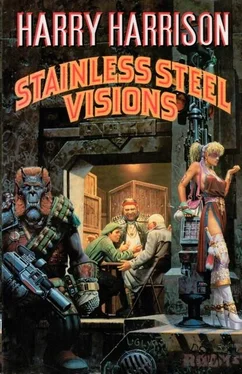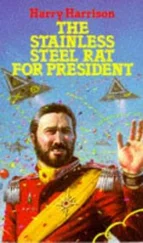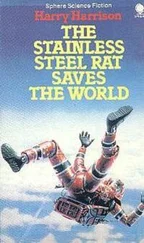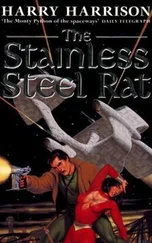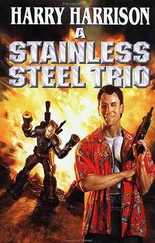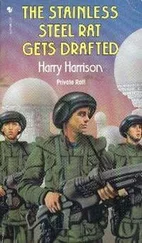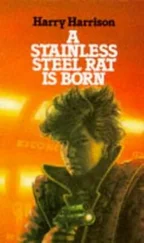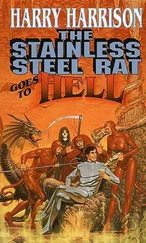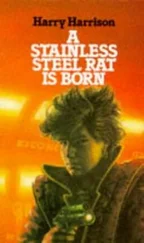Гарри Гаррисон - Stainless Steel Visions
Здесь есть возможность читать онлайн «Гарри Гаррисон - Stainless Steel Visions» весь текст электронной книги совершенно бесплатно (целиком полную версию без сокращений). В некоторых случаях можно слушать аудио, скачать через торрент в формате fb2 и присутствует краткое содержание. Год выпуска: 1993, Жанр: Фантастика и фэнтези, на английском языке. Описание произведения, (предисловие) а так же отзывы посетителей доступны на портале библиотеки ЛибКат.
- Название:Stainless Steel Visions
- Автор:
- Жанр:
- Год:1993
- ISBN:нет данных
- Рейтинг книги:5 / 5. Голосов: 1
-
Избранное:Добавить в избранное
- Отзывы:
-
Ваша оценка:
- 100
- 1
- 2
- 3
- 4
- 5
Stainless Steel Visions: краткое содержание, описание и аннотация
Предлагаем к чтению аннотацию, описание, краткое содержание или предисловие (зависит от того, что написал сам автор книги «Stainless Steel Visions»). Если вы не нашли необходимую информацию о книге — напишите в комментариях, мы постараемся отыскать её.
Stainless Steel Visions — читать онлайн бесплатно полную книгу (весь текст) целиком
Ниже представлен текст книги, разбитый по страницам. Система сохранения места последней прочитанной страницы, позволяет с удобством читать онлайн бесплатно книгу «Stainless Steel Visions», без необходимости каждый раз заново искать на чём Вы остановились. Поставьте закладку, и сможете в любой момент перейти на страницу, на которой закончили чтение.
Интервал:
Закладка:
STAINLESS STEEL VISIONS
Harry Harrison
INTRODUCTION
It was wonderful to grow up in the world of the pulp magazines. Brassy and colorful they were, filled with adventure and wondrous machines. Some of the many categories invented in the thirties still exist today, in book if not magazine form; love and romance, Western and detective. Many categories have slipped away — air war and battle stories — while many heroes are now forgotten. In what lonely grave does Operator Number 5 lie? Close to The Spider, Cash Gorman, G8 and his Battle Aces no doubt.
Give science fiction that; although its magazine existence has tottered, down from around sixty titles a month to three or four, it never died. SF magazines still publish more short stories in a year than magazines dedicated to any other kind of fiction.
At the age of seven or eight I did not notice the deficiencies of this particular art form. Yes, I did read all kinds of pulps— except Western or romance. (Particularly loathsome was that hybrid, Rangeland Romances.) But my attention strayed more and more to science fiction until I was reading all that was being published. It was exciting, that was what counted. Having no critical standards, I did not notice the banality of the writing, the repetition and the hackwork. Excitement was what mattered, emotional and intellectual — that was the double-barreled attraction of SF. Still is. Where else can you get the machine as hero? This was good stuff, still is good stuff. When written well nothing can better it.
I sharpened my literary teeth on the short story. It is a concise art form with a beginning, middle, and end. The reader must be attracted by the opening, get involved with the middle — and be surprised by the ending. Surprised not only by the sharp twist of an O. Henry ending, but captured by the surprise of a laugh or smile, sharp contrast or relief.
(An O. Henry ending is best exemplified by his "Gift of the Magi. " Where the poverty-stricken couple exchange presents. He sells his watch to buy a set of combs for her beautiful hair — but she has had her hair cut and sold it to buy a fob for his watch….)
The opening must charm and entice the reader. In the pulp days this was known as a narrative hook. Something to hook the editor into turning to the second page. The first page of a story manuscript — double-spaced, of course — has the author's name and address in the upper left corner, word-length in the upper right. The title is halfway down the page, leaving a lot of white space for editorial typesetting advice. The word "by" takes up a line, as does the name or pseudonym under which the story is to be published. Which leaves only about eight lines of copy. Since pulp editors were faced with a mountain of unsolicited dreck every day, anything that got them to turn to the second page would probably get them to buy the story. This first-page copy was the narrative hook.
I once practiced writing these narrative hooks, wrote a great bundle of them. One of them hooked me so much that I went on to write a story to find out what happened next. This is what I wrote:
"James Bolivar diGriz I arrest you on the charge—"
I was waiting for the word "charge, " I thought it made a nice touch that way. As he said it I pressed the button that set off the charge of black powder in the ceiling. The crossbeam buckled and the three-ton safe dropped through right on top of the cop's head. He squashed very nicely, thank you. The cloud of plaster dust settled and all I could see of him was one hand, slightly rumpled. It twitched a bit and the index finger pointed at me accusingly. His voice was a little muffled by the safe and sounded a bit annoyed.
The story was titled "The Stainless Steel Rat. " It was later incorporated into a novel of the same name — the first in the series. Writing narrative hooks had proven a profitable exercise.
Every science-fiction writer has been asked, more than once, where those crazy ideas come from. (I know one writer whose response is that he buys them from a man in Reading, Pennsylvania.) There is no single answer. I know another writer who kept a small shelf of works by what he termed original story writers. When he needed a story fast he would pick a story at random, glance through it — then turn the plot on its head.
Then there is the greed-and-glory ploy. It is always a pleasure to sell a story to a magazine; an even greater pleasure when it is the cover story. Illustrated by the cover painting. Fred Pohl, then editor of Galaxy, had a publisher who could not resist a bargain. Fred worked from home most days a week. When he wasn't in the office the publisher would see all the budding painters who wanted to be cover artists. If their samples of artwork had some tiny degree of talent, and were suitably cheap, he would buy them. And leave them in the office as a rude shock for Fred when next he appeared.
After a bit the editorial office began to look like an exhibition of the totally incompetent. There were as many bad artists as there were bad writers. Very rarely one of these smears would be of cover quality. When I visited Galaxy and one of them caught my eye, Fred would force a photocopy of the cover upon me — or any other visiting author. Because if he could get a story that matched the painting he would have a free cover, which did wonders for the editorial budget. It was a challenge to fit all the strange elements of the art into a story; a challenge I rose to a number of times. Money and fame, a cover story the hard way.
Occasionally a story would be commissioned, a practice more common today. Isaac Asimov roughed out some possible world futures, each one brought about by a different advance in biology. Bob Silverberg edited an anthology of stories that fleshed out these futures. One of these intrigued me, and you will read "Brave Newer World" here.
When the great editor John W. Campbell died, I edited an anthology of original stories done in his memory. A last tribute by his authors. It turned into a sort of end-of-series tribute with Poul Anderson writing a last Van Rijn space trader story, Clifford Simak doing a last City story. Others did the same. I wrote the story "The Mothballed Spaceship" featuring the characters from my "Deathworld" trilogy.
Looking at the stories here triggers some interesting memories — often a history longer than the story itself. I had the plot of "The Streets of Ashkelon" cooking on the back burner of the mind for many years. I did not write it, because I knew that no editor would dare buy it in those years of prudery and self-censorship. It wasn't until Judy Merril decided to edit a book of taboo-breaking stories that I actually wrote the story. It was accepted for the anthology titled, I think, The Thin Edge, and paid for. The book never appeared, for publishing reasons now completely forgotten. With some difficulty I regained the rights to the story and watched while it was rejected by every magazine in the United States. Unlike the USA, Great Britain admits that atheists exist and do not eat children; there are even professed atheists in Parliament. So this story appeared in the English magazine New Worlds and was anthologized as well by Brian Aldiss. After a great many years it did cross the ocean and even appeared in an anthology of teenage science fiction.
Writing short stories is good training for the novelist. Among other things, it teaches economy of language. Every word must count in the short story, must be important and essential. Or it must be thrown out. Writers who practice this dictum are Brian Aldiss, Thomas M. Disch, and Robert Sheckley. Their stories move and sing and captivate.
Would there were more like them. I have read too many short stories that just didn't work. Because, like many others in the early days of SF, I wore many different hats. I have edited magazines, edited alone or in collaboration over fifty anthologies, illustrated SF magazines and done SF book jackets. I feel that I have learned from this process and my stories have profited.
Читать дальшеИнтервал:
Закладка:
Похожие книги на «Stainless Steel Visions»
Представляем Вашему вниманию похожие книги на «Stainless Steel Visions» списком для выбора. Мы отобрали схожую по названию и смыслу литературу в надежде предоставить читателям больше вариантов отыскать новые, интересные, ещё непрочитанные произведения.
Обсуждение, отзывы о книге «Stainless Steel Visions» и просто собственные мнения читателей. Оставьте ваши комментарии, напишите, что Вы думаете о произведении, его смысле или главных героях. Укажите что конкретно понравилось, а что нет, и почему Вы так считаете.
